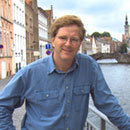Welsh Magic
Published in Rick Steves' Europe
For 20 years, I've built my North Wales coverage around a medieval banquet at Ruthin Castle. Driving into Ruthin -- and knowing its banquet was out of business -- I intended to cut the town entirely from my book. I was on edge, moody, as if I were about to commit a violent act. I was mad that the town would drop the one thing that put it on my map. I was going to kill it.
But as soon as I entered my good old Ruthin -- and saw the funky half-timbered pubs, the humble fountain, the cheap-but-beloved WWI monument, the home where Cynthia Lennon lived after John left her, the church with the never-locked wrought-iron gate where everything is in Welsh, and the views down cobbled lanes leading directly into forested hills -- I lost my nerve. I knew I'd have to keep it in my book. Even without the banquet, I couldn't cut Ruthin entirely. I scaled down the coverage in my guidebook, but kept the city.
Welsh magic is like that. From towering Mount Snowdon to powerful castles to Elizabethan homes, it's a poem written into the landscape. And that poetry has its own language. Despite centuries of English imperialism, the Welsh language remains alive and well. Though everyone in Wales speaks English, one in five can also speak the native tongue. In the northwest, well over half the population is fluent in Welsh, and uses it in everyday life.
Less urbanized and less wealthy than England, Wales consists of miles of green land where sheep graze (because the soil is too poor for crops). Behind the pastures, you'll often see a stony fortress. Some claim that Wales has more castles per square mile than any place in Europe. Most of them are English castles, built in the 13th century by King Edward I to establish English rule here and subdue the feisty Welsh.
One of the greatest of Edward's castles is Conwy Castle -- a masterpiece of medieval engineering. Its towers are round -- tougher to break through with no corners to knock off. The castle-within-a-castle defense gave defenders a place to retreat and wreak havoc on the advancing enemy ... or just wait for reinforcements. Finished in just four years, it has a water gate that allowed safe entry for English boats in a land of hostile Welsh subjects (www.cadw.wales.gov.uk).
The town of Conwy also has "the oldest house in Wales," Plas Mawr, built in 1580. In its heyday, visitors stepping into the house were wowed by the heraldry over the fireplace. This symbol, now repainted in its original bright colors, proclaims the family's rich lineage and princely stock. Its kitchen comes with all the circa-1600 conveniences: hay on the floor to add a little warmth and soak up spills; a hanging bread cage to keep food away from wandering critters; and a good supply of fresh meat in the pantry (take a whiff). Inside you'll also find a well-done exhibit on health and hygiene in medieval Britain -- you'll be grateful that you were born centuries later.
Wales isn't just grand old castles and Tudor mansions -- there's plenty of people action, too. I've always enjoyed listening to the mellow voices of a Welsh choir, but while in Conwy, I discovered another Welsh obsession -- a bingo parlor. Nearly every evening, you'll see participants who are very serious about their bingo. As the woman announcer calls numbers with her mesmerizing chant ("Eight and seven ... eighty-seven; all the twos ... twenty-two; only five ... number five"), intense, dressed-up old ladies play blot-the-numbers. The tension breaks each time someone calls "Line!" (the British version of yelling "Bingo!"). I liked the note posted on the wall: "If you bring your own teabag, you'll still have to pay 40 pence" (for the hot water).
To really appreciate North Wales, you need to step outside to see its natural beauty. Look for Mount Snowdon, the tallest mountain in Wales and England. Each year, half a million people ascend one of seven different paths to the top of the 3,560-foot mountain. Hikes take from five to seven hours; if you're fit and the weather's good, it's an exciting day.
Mountaineers note that Sir Edmund Hillary and his men used this area as they practiced for the first successful ascent of Mount Everest. They slept at the Pen-y-Gwryd Hotel Pub, at the base of the road leading up to the Pen-y-Pass by Mount Snowdon. Today, the bar is strewn with fascinating memorabilia from Hillary's climb in 1953.
From its dramatic castles to its evocative landscape and history, from its scenic beauty to its friendly people, Wales casts an impressive sightseeing spell.
========
Rick Steves (www.ricksteves.com) writes European travel guidebooks and hosts travel shows on public television and public radio. Email him at rick@ricksteves.com.
(c)2008 RICK STEVES DISTRIBUTED BY TRIBUNE MEDIA SERVICES, INC.














Comments